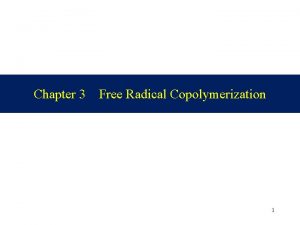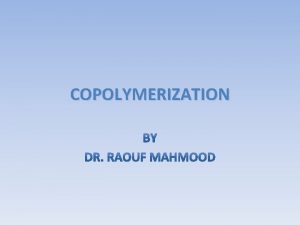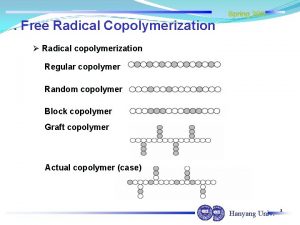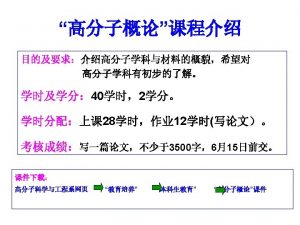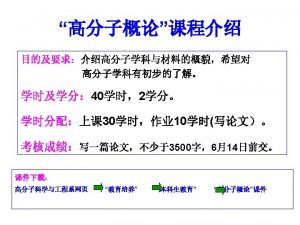COPOLYMERIZATION Polymer Modification o For a polymer to












- Slides: 12

COPOLYMERIZATION

Polymer Modification o For a polymer to be useful, it must be able to function properly in a given application. o The performance of a polymer is determined primarily by: 1. Composition of the polymer molecule 2. Structure of the polymer molecule. o These control the physical, chemical, and other characteristics of the polymer material. Therefore, modification of the composition of the structural units represents one of the main approaches to the modification of polymer behavior.

Polymer Modification o In addition to the chemical nature and composition of the structural units that constitute the polymer backbone, molecular architecture also contributes to the ultimate properties of polymeric products. Thus, polymer modification can be accomplished by employing one or more of the following techniques: Ø Copolymerization of more than one monomer Ø Control of molecular architecture Ø Postpolymerization polymer reactions involving functional/reactive groups introduced purposely into the polymer main chain or side groups

Polymer Modification However, fewer polymers are used technologically in their chemically pure form. Virtually all commercially available polymeric materials are a combination of one or more polymeric systems with various additives designed, with due consideration to cost factors, to produce an optimum property and/or process profile for specific applications.

COPOLYMERIZATION Macromolecular design and architecture through copolymerization of monomers has led to a number of commercially important polymers. Copolymer composition can be varied over wide limits, resulting in a wide range of property/process performance. A copolymer may be composed of similar amounts of the basic monomers. The properties of the resulting copolymer will be substantially different from those of the parent homopolymers.

COPOLYMERIZATION On the other hand, the copolymer may contain only a very small amount of one of the monomers. In this case, the gross physical characteristics of the copolymer probably near those of the homopolymer of the major constituent, while the minor constituent confers specific chemical properties on the copolymer.

COPOLYMERIZATION When a mixture of more than one (or different) monomeric samples is allowed to polymerize and form a copolymer , then we call this process as copolymerization. Example- Nylon 66 is a copolymer of hexamethylenediamine and adipic acid.

COPOLYMERIZATION There are four different types of copolymers existing: • Alternating copolymers: The copolymers which have two units placed at alternating positions. For example, we place a unit A then B, then A and then again B and the chain goes on. • The above figure shows the arrangement of alternating copolymers.

COPOLYMERIZATION • Periodic copolymers: The units of both A and B is arranged in a repetitive sequence. The arrangement is as shown below:

COPOLYMERIZATION • Statistical copolymers: The arrangement of polymers in this case follows a statistical rule. When the probability of finding a given monomer at a particular point is equal to the mole fraction of that monomer in the same chain, then the polymer is referred to as a random copolymer. It has the following arrangement:

COPOLYMERIZATION • Block copolymers: When two or more polymers are linked by homopolymers then they are called as block copolymers.

References 1. Robert O. E. , “polymer science and technology, CRC Press, USA, 2000. 2. Sperling L. H. , “Introduction to physical polymer science”, John Wiley & Sons, Inc. USA, 4 th Ed. 1932.
